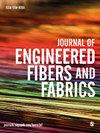A methodological framework for the integration of 3D virtual prototyping into the design development of laser-cut garments
IF 2.3
4区 工程技术
Q1 MATERIALS SCIENCE, TEXTILES
引用次数: 0
Abstract
3D virtual prototyping for garment development, although not much exploited and appreciated by the clothing industry in the early days of its appearance two decades ago, has now been explored (research-wise) extensively especially in the pandemic period and its impact on the whole supply chain of garments and fashion products. This virtual prototype which allows the company to visualize the status and condition of a clothing product that may be thousands of kilometers away, providing insights into how products can be better designed, manufactured, operated and serviced before companies invest in physical prototypes and assets, is often called digital twin. At the same time, laser-cut as a creative design technique on clothing materials have emerged in recent times, as fashion moguls are seeing the benefits that the technology presents. Laser cut technology with its benefits of accuracy, speed, precision, applicability in various materials, flexibility in geometry, interoperability with other systems like CAD/CAM and CIM, sustainability in resources and source of inspiration for several upcoming designers, provides an excellent approach for creating bridges between the past, the present and the future in history of fashion design. The aim of this paper was to provide a decision-making framework for the selection of an effective digital twinning process with the use of two different 3D virtual prototyping tools. For this purpose, a methodological framework is proposed which guides the creator according to the final use of the digital garment twin: evaluation of actual fit and actual representation of the produced physical, or as a shared digital asset for an exclusive digital environment.将3D虚拟样机集成到激光切割服装设计开发中的方法框架
用于服装开发的3D虚拟样机,尽管在20年前出现的早期并没有得到服装行业的广泛开发和赞赏,但现在已经得到了广泛的探索(研究方面),尤其是在疫情期间及其对服装和时尚产品整个供应链的影响。这种虚拟原型使公司能够可视化数千公里外服装产品的状态和状况,从而在公司投资实物原型和资产之前,深入了解如何更好地设计、制造、运营和服务产品,通常被称为数字孪生。与此同时,随着时尚巨头们看到这项技术带来的好处,激光切割作为一种服装材料的创造性设计技术近年来出现了。激光切割技术具有准确性、速度、精度、在各种材料中的适用性、几何形状的灵活性、与CAD/CAM和CIM等其他系统的互操作性、资源的可持续性以及未来几位设计师的灵感来源等优点,为在过去、,时装设计史上的现在和未来。本文的目的是为使用两种不同的三维虚拟样机工具选择有效的数字孪生工艺提供一个决策框架。为此,提出了一个方法框架,根据数字服装双胞胎的最终用途指导创作者:评估实际合身度和生产实物的实际表现,或作为专属数字环境的共享数字资产。
本文章由计算机程序翻译,如有差异,请以英文原文为准。
求助全文
约1分钟内获得全文
求助全文
来源期刊

Journal of Engineered Fibers and Fabrics
工程技术-材料科学:纺织
CiteScore
5.00
自引率
6.90%
发文量
41
审稿时长
4 months
期刊介绍:
Journal of Engineered Fibers and Fabrics is a peer-reviewed, open access journal which aims to facilitate the rapid and wide dissemination of research in the engineering of textiles, clothing and fiber based structures.
 求助内容:
求助内容: 应助结果提醒方式:
应助结果提醒方式:


